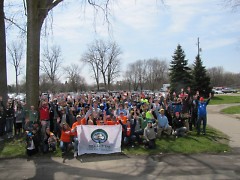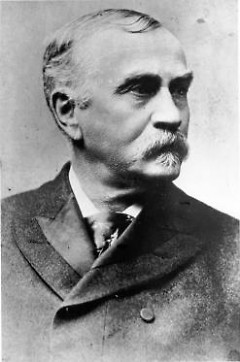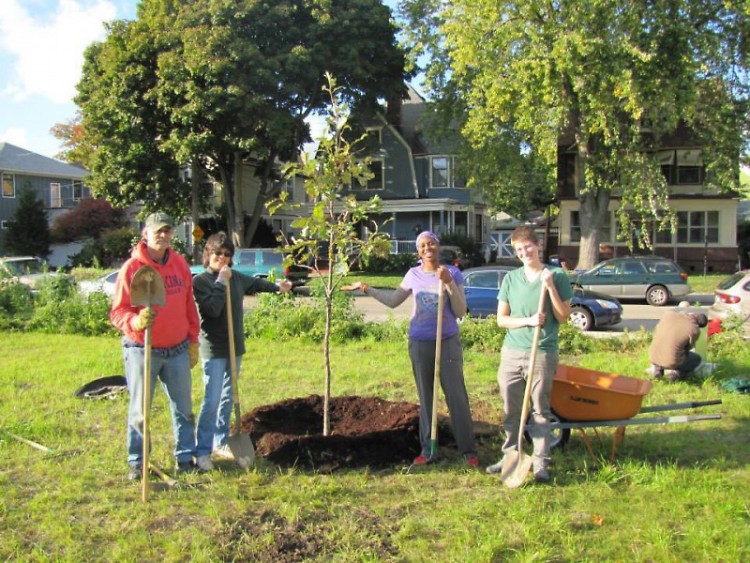In 2013, Friends of GR Parks was awarded the Excellence in Urban Forestry Award from the Arbor Day Foundation for the Grand Rapids Urban Forest Project. Celebrating Arbor Day in Grand Rapids is a great way to bring people back to why trees matter in our community. Arbor Day unlike other holidays doesn’t celebrate the past, but instead it celebrates the future.
“Ordinary holidays are retrospective," explains Arbor Day founder Julius Morton. "They honor something good and great which has been, and, by its exaltation, commend it to the emulation of mankind. Thus the past is made to inspire the present, and the present to reach into and influence the immeasurable and unknowable future. But ‘Arbor Day’ contemplates not the good and the beautiful of past generation, but instead it sketches, outlines and established the useful and the beautiful for the ages yet to come. It is the sole holiday of the human family which looks forward and not backward.”
Julius Sterling Morton was a politician, author, editor, outdoors enthusiast, conservationist and most notably the impetus behind the designation of Arbor Day. Morton was born in Adams, New York, but the majority of this influential years were spent in Albion, Michigan where he went to school. Morton from a very young age was passionate about nature, trees and the outdoors. He was living in Michigan when the mighty white pine and old growth forest still dominated our landscape. After prep school Morton then went on to attended the University of Michigan. From there, Morton went to Union College in New York where he received a B.A. Morton then moved back to Detroit, MI to work as a reporter at the Detroit Free Press. In October of 1854, Morton married Caroline Joy, and on the day of their marriage Morton and his young bride headed westward to the “new land” of Nebraska. It was the spirit of adventure that drove this couple from established jobs and families to the west where even the grains for food were yet to be sown. The Morton’s settled briefly in Bellevue the initial point of settlement in this new territory, but quickly relocated to Nebraska City where they began to build their home which is known as Arbor Lodge. The Mortons' homestead was vast, but described as a “naked prairie” with strong heavy grasses that formed tough sod which had never been broken. Morton’s wife had also spent her youth and young adult life in Michigan where she also developed a great love and appreciation for nature, trees and the outdoors. Together this young couple began cultivating their homestead and planting numerous species of trees.
In 1858, Morton, a democrat that clung tenaciously to the party’s traditions, was appointed by President James Buchanan to serve as the Secretary of the Nebraskan Territory. In 1959, Morton served as the acting governor, and in 1860 he was a candidate for Congress. Ultimately, due to an overwhelming number of Republicans in the Congressional House, Morton’s seat in Congress was contested and he lost the election. This was the start to a series of political defeats. Morton, with support from his wife, drew his attention back to their homestead at Arbor Lodge. Morton began experiments on various tree plantings, researching what variety of arboriculture would have the best success in Nebraska’s soils and climate. He became the president to the State Board of Agriculture and even linked desired role of “patriotism” with planting trees and caring for the aesthetics of one’s home. Morton urged that Nebraska, like his former state, Michigan, could become a powerful entity through the planting of trees which could provide both environmental and economic benefits. As a result, Morton proposed to the Nebraska State Board of Agriculture, that there be a designated day set aside in the year of 1872 for the planting of trees. He proposed April 10, 1872 and titled it “Arbor Day.” This proposal was unanimously adopted and Morton dubbed this, “the battle against the treeless prairies.” This event was so successful that Arbor Day was made an annual event in Nebraska and was celebrated from 1885 on April 22 the anniversary of Morton’s own date of birth. This idea of Arbor Day and planting trees was eventually adopted by all U.S. States and many foreign countries, but because of regional climate differences the exact date of Arbor Day is not the same throughout the country and the world. The most commonly observed day is the last Friday in April.
Morton’s idea of Arbor Day came during a devastating time in forestry throughout the country. The forested land of Michigan and other heavily logged states were completely devastated. The implementation of Arbor Day was very influential and help lead Congress to attempt to establish laws and regulations on such rapid utilization. Morton received his highest political honor when he was appointed by President Grover Cleveland US Secretary of Agriculture and at this same time he also served as the president of the American Forestry Associations. Morton and his wife continued to live at Arbor Lodge and had four sons who all inherited their parents love for trees, conservation, and the outdoors. The entire family lived prosperous lives and continued this legacy that their father worked so hard to obtain. Morton was a true conservationist before that term was even fully understood or developed. Following Morton’s death in 1902, the family donated the Arbor Lodge homestead to the state and it is now known as Arbor Lodge State Historical Park.
The Rapidian, a program of the 501(c)3 nonprofit Community Media Center, relies on the community’s support to help cover the cost of training reporters and publishing content.
We need your help.
If each of our readers and content creators who values this community platform help support its creation and maintenance, The Rapidian can continue to educate and facilitate a conversation around issues for years to come.
Please support The Rapidian and make a contribution today.



